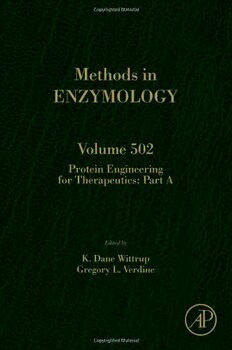
Protein Engineering for Therapeutics, Part A PDF
Preview Protein Engineering for Therapeutics, Part A
METHODS IN ENZYMOLOGY Editors-in-Chief JOHN N. ABELSON MELVIN I. SIMON AND Division of Biology California Institute of Technology Pasadena, California Founding Editors SIDNEY P. COLOWICK NATHAN O. KAPLAN AND AcademicPressisanimprintofElsevier 525BStreet,Suite1900,SanDiego,CA92101-4495,USA 225WymanStreet,Waltham,MA02451,USA 32JamestownRoad,LondonNW17BY,UK Firstedition2012 Copyright#2012,ElsevierInc.AllRightsReserved. Nopartofthispublicationmaybereproduced,storedinaretrievalsystemortransmittedinany formorbyanymeanselectronic,mechanical,photocopying,recordingorotherwisewithoutthe priorwrittenpermissionofthepublisher PermissionsmaybesoughtdirectlyfromElsevier’sScience&TechnologyRightsDepartment inOxford,UK:phone(+44)(0)1865843830;fax(+44)(0)1865853333;email:permissions@ elsevier.com.AlternativelyyoucansubmityourrequestonlinebyvisitingtheElsevierwebsiteat http://elsevier.com/locate/permissions,andselectingObtainingpermissiontouseElseviermaterial Notice No responsibility is assumed by the publisher for any injury and/or damage to persons or propertyasamatterofproductsliability,negligenceorotherwise,orfromanyuseoroperation ofanymethods,products,instructionsorideascontainedinthematerialherein.Becauseofrapid advancesinthemedicalsciences,inparticular,independentverificationofdiagnosesanddrug dosagesshouldbemade ForinformationonallAcademicPresspublications visitourwebsiteatelsevierdirect.com ISBN:978-0-12-416039-2 ISSN:0076-6879 PrintedandboundinUnitedStatesofAmerica 12 13 14 10 9 8 7 6 5 4 3 2 1 C ONTRIBUTORS GiuliaAgnello Institute for Cellular and Molecular Biology, University of Texas, Austin, Texas, USA JagadishBeloor Department of Bioengineering and Institute for Bioengineering and Biopharma- ceuticalResearch,HanyangUniversity,Seoul,SouthKorea MichaelT.Bethune DivisionofBiology,CaliforniaInstituteofTechnology,Pasadena,California,USA Yu(Joshua)Cao ImmunopharmacologyandTargetedTherapyLaboratory,DepartmentofExperi- mentalTherapeutics,M.D.AndersonCancerCenter,Houston,Texas,USA JasonR.Cantor DepartmentofChemicalEngineering,UniversityofTexas,Austin,Texas,USA AshutoshChilkoti Department of Biomedical Engineering and Center for Biologically Inspired MaterialsandMaterialSystems,DukeUniversity,Durham,NorthCarolina,USA DarylC.Drummond MerrimackPharmaceuticals,Cambridge,Massachusetts,USA ChelcieH.Eller Department of Biochemistry, University of Wisconsin–Madison, Madison, Wisconsin,USA TarekM.Fahmy DepartmentofBiomedicalEngineering,YaleUniversity,NewHaven,Connecticut, USA GeorgeGeorgiou Department of Chemical Engineering; Institute for Cellular and Molecular Biology; Section of Molecular Genetics and Microbiology; and Department of BiomedicalEngineering,UniversityofTexas,Austin,Texas,USA TariqGhayur BiologicsDepartment,AbbottBioresearchCenter,Worcester,Massachusetts,USA ix x Contributors JijieGu BiologicsDepartment,AbbottBioresearchCenter,Worcester,Massachusetts,USA BrianD.Harms MerrimackPharmaceuticals,Cambridge,Massachusetts,USA WafaHassouneh Department of Biomedical Engineering, Duke University, Durham, North Carolina,USA MarkE.Hayes MerrimackPharmaceuticals,Cambridge,Massachusetts,USA ZhaohuaHuang MerrimackPharmaceuticals,Cambridge,Massachusetts,USA JeffreyD.Kearns MerrimackPharmaceuticals,Cambridge,Massachusetts,USA ChaitanKhosla DepartmentofChemicalEngineering;DepartmentofChemistry,andDepartment ofBiochemistry(bycourtesy),StanfordUniversity,Stanford,California,USA DmitriB.Kirpotin MerrimackPharmaceuticals,Cambridge,Massachusetts,USA NeerajKohli MerrimackPharmaceuticals,Cambridge,Massachusetts,USA TadKornaga MerrimackPharmaceuticals,Cambridge,Massachusetts,USA PritiKumar Department of Internal Medicine/Section for Infectious Diseases, Yale School of Medicine,NewHaven,Connecticut,USA Sang-KyungLee Department of Bioengineering and Institute for Bioengineering and Biopharma- ceuticalResearch,HanyangUniversity,Seoul,SouthKorea;DepartmentofInter- nal Medicine/Section for Infectious Diseases, Yale School of Medicine, New Haven,Connecticut,USA JoE.Lomax Graduate Program in Cellular & Molecular Biology, University of Wisconsin– Madison,Madison,Wisconsin,USA RobertP.Lyon SeattleGenetics,Bothell,Washington,USA Contributors xi Mi-AeLyu ImmunopharmacologyandTargetedTherapyLaboratory,DepartmentofExperi- mentalTherapeutics,M.D.AndersonCancerCenter,Houston,Texas,USA SarahR.MacEwan Department of Biomedical Engineering, Duke University, Durham, North Carolina,USA JamesD.Marks Department of Anesthesia and Perioperative Care, University of California, San Francisco,California,USA DavidL.Meyer SeattleGenetics,Bothell,Washington,USA KhalidA.Mohamedali ImmunopharmacologyandTargetedTherapyLaboratory,DepartmentofExperi- mentalTherapeutics,M.D.AndersonCancerCenter,Houston,Texas,USA UlrikB.Nielsen MerrimackPharmaceuticals,Cambridge,Massachusetts,USA CharlesO.Noble MerrimackPharmaceuticals,Cambridge,Massachusetts,USA VasilikiPanayiotou DepartmentofChemicalEngineering,UniversityofTexas,Austin,Texas,USA RonaldT.Raines Department of Biochemistry and Department of Chemistry, University of Wisconsin–Madison,Madison,Wisconsin,USA SaravananRajan TerrenceDonnellyCentreforCellularandBiomolecularResearch,Universityof Toronto,Toronto,Ontario,Canada MichaelG.Rosenblum ImmunopharmacologyandTargetedTherapyLaboratory,DepartmentofExperi- mentalTherapeutics,M.D.AndersonCancerCenter,Houston,Texas,USA BirgitSchoeberl MerrimackPharmaceuticals,Cambridge,Massachusetts,USA PeterD.Senter SeattleGenetics,Bothell,Washington,USA JocelynR.Setter SeattleGenetics,Bothell,Washington,USA xii Contributors SachdevS.Sidhu Terrence Donnelly Centre for Cellular and Biomolecular Research; Banting and Best Department of Medical Research; and Department of Molecular Genetics, UniversityofToronto,Toronto,Ontario,Canada AlyssaSiefert DepartmentofBiomedicalEngineering,YaleUniversity,NewHaven,Connecticut, USA EverettM.Stone DepartmentofBiomedicalEngineering,UniversityofTexas,Austin,Texas,USA StephenV.Su MerrimackPharmaceuticals,Cambridge,Massachusetts,USA YuZhou Department of Anesthesia and Perioperative Care, University of California, San Francisco,California,USA P REFACE ThesetwovolumesofMethodsinEnzymologycoverengineeringapproaches to the development of protein biopharmaceuticals, which represent a significantandrapidlygrowingproportionofdrugsales.Particularadvan- tages of proteins as drugs relative to small organic molecules include high affinity and specificity afforded by a larger molecular recognition surface and much lower probability of off-target toxicities due to metabolic byproducts. The primary disadvantage to date has been the pharmacoki- netic inaccessibility of intracellular drug targets to proteins and peptides, although vigorous efforts at overcoming this limitation are beginning to bear fruit. The protein biopharmaceutical field was born with the advent of recombinant DNA expression systems for natural human protein agonists such as insulin, human growth hormone, erythropoietin, and granulocyte colony-stimulating factor. Humanization of mouse antibodies opened the playing field to novel molecules that specifically bound to and blocked receptors and ligands important in a variety of diseases. In vitro directed evolutiontechnologieshaveenabledfurtherexplorationofnonnativestruc- tures and topologies for target antagonism or delivery of therapeutic pay- loads. It should be pointed out that to date protein engineering has made minimal progress in engineering the agonists which were the first protein biopharmaceuticals. Such engineered agonists could enable more subtle redirection of innate homeostatic regulatory pathways than the relatively crude tools of antibody antagonism or parenteral oversupply of naturally occurring protein and peptide agonists. We provide here only an overview representing the wide spectrum of approachesinthisfield.Thefirstsectioncoverssomeaspectsofantibodies, byfarthedominantclassofproteinbiopharmaceuticalsatthepresenttime. Thesecondsectionprovidesexampleswhereproteintargetingisexploited to deliver a payload conjugated to the proteins. In the third section of the firstvolume,examples ofengineeredtherapeuticenzymes areprovided.In the first section of the second volume, peptides are considered, enabling chemicalsynthesisandmorefacileintracellulardelivery,giventheirsmaller size. The second section describes a number of leading efforts to engineer molecularrecognitionontoascaffoldotherthanthatofanantibody.Inthe third and final section, pharmacokinetics of protein drugs is discussed with xiii xiv Preface respect to delivery to tumors, intracellular targets, and across the blood– brain barrier. We particularly thank the authors of these contributions for their thor- ough and clear exposition of the state of the art in their respective specializations. K. DANE WITTRUP AND GREGORY L. VERDINE M E ETHODS IN NZYMOLOGY VOLUMEI.PreparationandAssayofEnzymes EditedbySIDNEYP.COLOWICKANDNATHANO.KAPLAN VOLUMEII.PreparationandAssayofEnzymes EditedbySIDNEYP.COLOWICKANDNATHANO.KAPLAN VOLUMEIII.PreparationandAssayofSubstrates EditedbySIDNEYP.COLOWICKANDNATHANO.KAPLAN VOLUMEIV.SpecialTechniquesfortheEnzymologist EditedbySIDNEYP.COLOWICKANDNATHANO.KAPLAN VOLUMEV.PreparationandAssayofEnzymes EditedbySIDNEYP.COLOWICKANDNATHANO.KAPLAN VOLUMEVI.PreparationandAssayofEnzymes(Continued) PreparationandAssayofSubstrates SpecialTechniques EditedbySIDNEYP.COLOWICKANDNATHANO.KAPLAN VOLUMEVII.CumulativeSubjectIndex EditedbySIDNEYP.COLOWICKANDNATHANO.KAPLAN VOLUMEVIII.ComplexCarbohydrates EditedbyELIZABETHF.NEUFELDANDVICTORGINSBURG VOLUMEIX.CarbohydrateMetabolism EditedbyWILLISA.WOOD VOLUMEX.OxidationandPhosphorylation EditedbyRONALDW.ESTABROOKANDMAYNARDE.PULLMAN VOLUMEXI.EnzymeStructure EditedbyC.H.W.HIRS VOLUMEXII.NucleicAcids(PartsAandB) EditedbyLAWRENCEGROSSMANANDKIVIEMOLDAVE VOLUMEXIII.CitricAcidCycle EditedbyJ.M.LOWENSTEIN VOLUMEXIV.Lipids EditedbyJ.M.LOWENSTEIN VOLUMEXV.SteroidsandTerpenoids EditedbyRAYMONDB.CLAYTON xv xvi MethodsinEnzymology VOLUMEXVI.FastReactions EditedbyKENNETHKUSTIN VOLUMEXVII.MetabolismofAminoAcidsandAmines(PartsAandB) EditedbyHERBERTTABORANDCELIAWHITETABOR VOLUMEXVIII.VitaminsandCoenzymes(PartsA,B,andC) EditedbyDONALDB.MCCORMICKANDLEMUELD.WRIGHT VOLUMEXIX.ProteolyticEnzymes EditedbyGERTRUDEE.PERLMANNANDLASZLOLORAND VOLUMEXX.NucleicAcidsandProteinSynthesis(PartC) EditedbyKIVIEMOLDAVEANDLAWRENCEGROSSMAN VOLUMEXXI.NucleicAcids(PartD) EditedbyLAWRENCEGROSSMANANDKIVIEMOLDAVE VOLUMEXXII.EnzymePurificationandRelatedTechniques EditedbyWILLIAMB.JAKOBY VOLUMEXXIII.Photosynthesis(PartA) EditedbyANTHONYSANPIETRO VOLUMEXXIV.PhotosynthesisandNitrogenFixation(PartB) EditedbyANTHONYSANPIETRO VOLUMEXXV.EnzymeStructure(PartB) EditedbyC.H.W.HIRSANDSERGEN.TIMASHEFF VOLUMEXXVI.EnzymeStructure(PartC) EditedbyC.H.W.HIRSANDSERGEN.TIMASHEFF VOLUMEXXVII.EnzymeStructure(PartD) EditedbyC.H.W.HIRSANDSERGEN.TIMASHEFF VOLUMEXXVIII.ComplexCarbohydrates(PartB) EditedbyVICTORGINSBURG VOLUMEXXIX.NucleicAcidsandProteinSynthesis(PartE) EditedbyLAWRENCEGROSSMANANDKIVIEMOLDAVE VOLUMEXXX.NucleicAcidsandProteinSynthesis(PartF) EditedbyKIVIEMOLDAVEANDLAWRENCEGROSSMAN VOLUMEXXXI.Biomembranes(PartA) EditedbySIDNEYFLEISCHERANDLESTERPACKER VOLUMEXXXII.Biomembranes(PartB) EditedbySIDNEYFLEISCHERANDLESTERPACKER VOLUMEXXXIII.CumulativeSubjectIndexVolumesI-XXX EditedbyMARTHAG.DENNISANDEDWARDA.DENNIS VOLUMEXXXIV.AffinityTechniques(EnzymePurification:PartB) EditedbyWILLIAMB.JAKOBYANDMEIRWILCHEK
